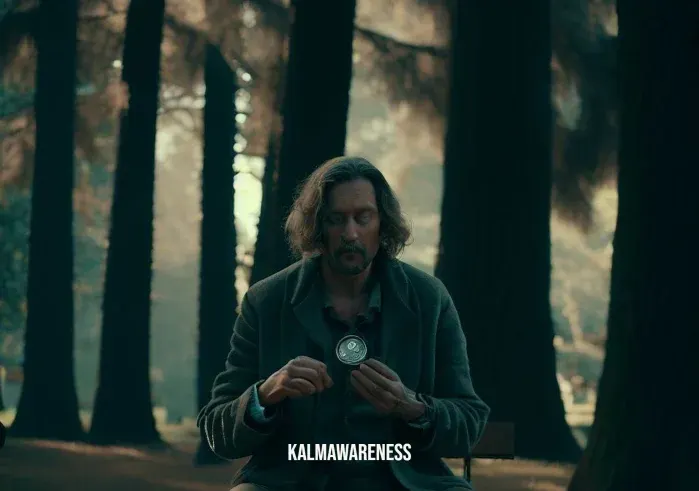Compare Yourself to an Object Speech: A Path to Self-Awareness
In the journey to self-awareness and personal growth, it’s important to find ways to understand and express who we are. One interesting method is the ‘compare yourself to an object speech.’ This unique concept offers a fresh perspective on self-reflection, encouraging us to identify our characteristics and how they reflect in our interactions with the world.
The Power of Metaphors
Imagine, if you will, that life is like a mirror. In this mirror, we see our reflection, which acts as a metaphor for life itself. This reflection can sometimes be distorted by our perceptions, and this is where the concept of ‘compare yourself to an object speech’ comes into play.
Compare yourself to an object speech is an introspective exercise that challenges us to draw parallels between our personal characteristics and those of an object. It requires insight and empathy, encouraging us to delve deep into our psyche to unravel layers of self-perception, much like peeling back the layers of an onion.
“Comparing oneself to an object can offer a unique perspective on our own strengths, weaknesses, and idiosyncrasies. It’s a tool for self-awareness and understanding.” – Anonymous
Why Compare Ourselves to an Object?
It may seem odd at first, but this comparison exercise can be incredibly revealing. It offers an opportunity to explore how others see us and how we see ourselves. For example, if you see yourself as a lighthouse, you might associate with characteristics such as guidance, resilience, and a beacon of hope for others. Understanding how others see us through this object comparison offers invaluable insight into our personal growth journey.
This introspection also allows us to clear our vision, to look past our biases and self-imposed limitations. It provides an avenue for clearing vision and opening our eyes to new perspectives.
Object Lessons and Insights
To further illustrate, consider an object lesson on worry. If we liken ourselves to a piece of coal under pressure, we might see our worries as the intense pressure that shapes us into diamonds. It’s an empowering way to visualize personal growth, reminding us that even in the face of challenges, we have the potential to transform and shine.
This technique is not just about self-reflection but also about empathy and understanding others. For instance, when we’re feeling small or insignificant, we might compare ourselves to a tiny seed, ready to sprout into something majestic given the right conditions. Through such comparisons, we’re able to better empathize with others and appreciate their unique journeys and struggles.
Finding Your Object
The process of identifying an object that aligns with your characteristics requires introspection and honest self-evaluation. The mirror perspective technique can help here, allowing us to see ourselves more clearly and objectively. From this vantage point, we can begin to understand our attributes, strengths, and areas of growth, enabling us to choose an object that truly represents us.
I invite you to continue to the next part of this article where we will dive deeper into how to craft a compelling ‘compare yourself to an object speech.’ We’ll also explore how this exercise can positively impact your personal growth journey, build empathy, and offer unique insights about yourself and others.

Crafting Your Compare Yourself to an Object Speech: Key Considerations
Having grasped the concept and significance of comparing yourself to an object, we now delve into the nuts and bolts of creating an impactful compare yourself to an object speech.
1. Choosing Your Object
The first step towards crafting your speech is choosing an appropriate object. As earlier explained, this should mirror your unique attributes and experiences. While there might be an urge to select objects we find fascinating or appealing, it’s crucial to remain grounded in authenticity. For instance, comparing oneself to a mirror could symbolize an ability to reflect the world around you, take in the good and the bad, and still remain true to oneself.
2. Identifying Key Characteristics
Once you’ve settled on your object, the next step is to outline its key characteristics. This requires a deep understanding of the object, considering all its facets. It’s advisable to make a list of these characteristics as a preliminary step. For instance, if you choose to compare yourself to an angel, as explored in Angelic Whispers, you might list traits like protection, guidance, and serenity.
3. Drawing Parallels
Now, it’s time to draw parallels between the object’s characteristics and your own. This step demands honesty and self-awareness. If the object is a mirror, for example, how well do you reflect the world around you? If it’s a seed, how much growth and potential do you possess? The idea here is to find the intersection between the object’s attributes and your own, forming the basis for your comparison.
| Object | Object’s Attributes | Your Corresponding Attributes |
|---|---|---|
| Mirror | Reflectivity, Transparency, Resilience | Ability to reflect experiences, Honesty, Perseverance |
| Seed | Potential, Growth, Resilience | Possibility for personal development, Ongoing learning, Overcoming adversity |
| Angel | Protection, Guidance, Serenity | Providing support, Leading by example, Maintaining calm in crisis |
| Lighthouse | Guidance, Resilience, Beacon of Hope | Directing others, Overcoming adversity, Inspiration to others |
| Diamond | Strength, Resilience, Brilliance | Inner strength, Coping with pressures, Outstanding personal qualities |
4. Structuring Your Speech
The structure of your speech is crucial. It should flow seamlessly, starting with an introduction that presents the object and its significance. The body should consist of the parallels drawn, providing compelling narratives or experiences that embody those comparisons. The conclusion should wrap up your thoughts and perhaps share the impact of this reflection on your self-perception. Remember, the aim is to deliver a speech that’s as insightful as it is inspiring.
5. Practicing Compassionate Directness
As you venture into this reflective exercise, remember the importance of compassionate directness. This entails being honest with oneself while also exhibiting self-compassion. Not all traits we discover about ourselves will be positive, and that’s okay. It’s about understanding, accepting, and looking for areas of improvement.
I invite you to continue to the next part of this article, where we’ll provide examples of ‘compare yourself to an object speeches.’ We’ll also discuss how to utilize feedback to refine your speech, using tools such as the “See yourself through the eyes of others” answer key, which fosters further self-awareness and growth. The chapter will also include some insightful tips to deliver your speech effectively, keeping your audience engaged and touched by your personal reflections.

Mastering Your Compare Yourself to an Object Speech: Examples, Feedback, and Delivery
In the previous sections, we learned how to craft a compare yourself to an object speech. Let’s explore the nuances of mastering such a speech by delving into examples, understanding how to use feedback effectively, and fine-tuning our delivery.
Samples to Inspire Your Speech
To bring everything together, let’s look at some examples. These could offer inspiration as you strive to craft your unique compare yourself to an object speech.
- The Lighthouse: “I am like a lighthouse, sturdy and tall. Through storms and calm, I stand strong, a beacon of hope for lost souls. Like a lighthouse, my resilience has been tested by life’s storms, yet I remain unbroken. My purpose, to guide, mirrors my passion for leadership, directing others towards a safe harbor in troubled times.”
- The Seed: “I liken myself to a seed, filled with potential, waiting for the right conditions to sprout. This seed represents my journey of personal growth and development. Just as a seed transforms into a tree, I too am constantly evolving, learning, and growing.”
Such examples serve as practical applications of the steps and considerations we’ve discussed.
Using Feedback for Improvement
Feedback plays a crucial role in personal development. By using tools such as the “See yourself through the eyes of others” answer key, we can obtain external perspectives on our speech, prompting us to examine areas we might have overlooked. Embracing feedback, particularly compassionate responses, aids us in refining our speech and fostering growth.
Effective Delivery
As Maya Angelou once said, “People will forget what you said, people will forget what you did, but people will never forget how you made them feel.” Delivery is as important as content in a speech. Mastering the art of delivery involves mindful relationship habits such as empathy, active listening, and respectful communication. As you present your speech, keep in mind that it’s not just about conveying information but also about creating an emotional connection with your audience.
Here are some tips for effective delivery:
- Practice: Like any other skill, effective delivery comes with practice. Repeat your speech until you’re comfortable with every word.
- Body Language: Your body language can either amplify or dampen your message. Ensure your posture, gestures, and facial expressions align with your words.
- Pace and Tone: Speak slowly and clearly to ensure your audience can follow along. Vary your tone to convey emotion and keep your audience engaged.
- Use of Silence: Strategic pauses can be powerful. They provide moments for your audience to absorb and reflect on what you’ve shared.
I invite you to continue to the final part of this article, where we’ll delve into the transformative potential of the compare yourself to an object speech, connecting the process to broader themes of self-awareness and growth. We will also discuss the importance of reflection as a tool for personal development, drawing from insights shared in the Dalai Lama’s meditation techniques and the concept of arising and passing away. Lastly, we’ll look at ways to integrate this reflective exercise into daily life, creating an ongoing journey of self-discovery.

The Transformative Potential of Compare Yourself to an Object Speech: Reflection, Insights, and Integration
Now, let’s dive into the transformational power of compare yourself to an object speech. Beyond mere words, it is an insightful exercise that promotes self-awareness and growth. We’ll explore the importance of reflection, insight, empathy, and integrating this self-discovery process into daily life.
The Power of Reflection
At the heart of a compelling compare yourself to an object speech is the practice of self-reflection. Through deep introspection, we can reach inner vision, enabling us to gain insights about ourselves and our journey. To quote Albert Einstein, “The only source of knowledge is experience.” As we reflect on our experiences, we learn more about our strengths, our values, and our ambitions.
A reflective table can help guide you through the self-reflection process:
| Questions to Consider | Insights | Actions to Take |
|---|---|---|
| How do I see myself? | ||
| What object best symbolizes my current state? | ||
| How does this object resonate with my personal experiences and aspirations? | ||
| What strengths and weaknesses does this object reflect about me? | ||
| How can I use this speech to inspire personal growth? |
By filling this table, you embark on an introspective journey, the results of which can be transformative.
Gleaning Insights
A compare yourself to an object speech offers an opportunity to glean insights about oneself. By comparing ourselves to an object, we metaphorically express our self-perception, echoing the sentiment of “Life is a mirror“.
One of the ways we can deepen our self-understanding is through meditation. Techniques like the 3rd Eye Chakra Frequency meditation or the Anja meditation can open us to new perspectives and insights about ourselves, which can be integrated into our speech.
Empathy and Connection
One of the beautiful outcomes of this exercise is that it fosters empathy. By sharing our unique metaphors, we create space for vulnerability, connecting us on a human level. As writer Stephen King once said, “We never know the impact of our words on other people’s lives.” By courageously sharing our compare yourself to an object speech, we not only inspire others but also make them feel less alone in their struggles.
Integrating Self-Discovery into Daily Life
The compare yourself to an object speech is not a one-time activity. As we grow and evolve, so does our chosen object. Embracing this constant change allows us to see life as a journey of arising and passing away, a series of transformations that mold us into the person we are meant to be.
As you walk this journey of self-discovery, remember the words of Harriet Tubman, “Every great dream begins with a dreamer. Always remember, you have within you the strength, the patience, and the passion to reach for the stars to change the world.”
We invite you to the concluding part of this article, where we’ll summarize our journey together. We’ll revisit key aspects of crafting a compare yourself to an object speech, explore its potential impact on personal growth, and affirm the essential role of self-awareness, reflection, and empathy in our lives.

The Art and Philosophy of a Compare Yourself to an Object Speech: From Metaphors to Self-Realization
This concluding chapter of our journey explores the intricacies and the depth of compare yourself to an object speech. We’ll delve into the power of metaphors, the philosophical nuances of this exercise, the emotions it evokes, and its potential to catalyze profound self-realization.
Unraveling the Power of Metaphors
The essence of a compare yourself to an object speech lies in the clever use of metaphors. Metaphors serve as a bridge, connecting our inner selves to the outer world. The words we use in our speech are like a mirror, reflecting our self-perceptions and innermost feelings. As we’ve discussed in “Life is like a mirror“, our external reality is often a reflection of our internal state.
In your speech, consider using powerful and evocative metaphors that resonate with your personal experiences. Remember, the object you choose to represent yourself isn’t merely symbolic—it’s an extension of you, a tangible manifestation of your being and your life’s journey.
Philosophy and Perspective: Understanding the Object
A compare yourself to an object speech is more than just a metaphor—it’s a philosophical exercise. It’s an invitation to think deeply about our existence and our role in the world. As we learn in “and to think…“, contemplating life from different perspectives can lead to profound realizations.
What does the object you’ve chosen say about your perspective on life, your values, and your aspirations? Perhaps you view life as an unending journey, like a flowing river. Or, you might compare yourself to a seed, embodying potential and continuous growth. Whatever your object may be, examining its symbolism can offer valuable insights into your life philosophy.
Evoking Emotion: From Empathy to Enlightenment
A compare yourself to an object speech is an emotional journey, filled with moments of joy, despair, fear, courage, and hope. As we’ve learned from “Feeling small…“, it’s perfectly normal to experience a wide spectrum of emotions during this process.
As you share your speech, you invite others to connect with you on an emotional level. This empathy can lead to enlightenment—understanding others through understanding yourself. In this way, a compare yourself to an object speech becomes an instrument of connection and compassion, inspiring others to embark on their own journeys of self-discovery.
Self-Realization: The Fruit of Reflection and Insight
A compare yourself to an object speech has the potential to catalyze self-realization, awakening us to our true nature. As we discussed in the article “Why is it so hard to love yourself?“, self-realization is a crucial aspect of self-love and acceptance.
Your speech can be a stepping stone towards a deeper understanding of yourself, a path leading to self-realization. As you discover the connections between your chosen object and your life, you’ll uncover new facets of your identity and gain a clearer picture of who you truly are.
We’ve journeyed together through the art and philosophy of crafting a compare yourself to an object speech, understanding its emotional impact and transformative potential. Our exploration has illuminated how this unique exercise facilitates self-reflection, insights, empathy, and self-realization. It’s been a journey of discovery, from the first metaphor to the final realization. May the insights gained inspire you in your continuous journey of personal growth.

Epilogue: Embracing the Journey – Comparing Yourself to an Object
As we come to the end of our discussion on compare yourself to an object speech, we realize that this process is not merely an exercise but a journey. It’s a voyage of self-exploration, of deep reflections, and of rediscovering our selves through seemingly ordinary objects. It’s a testament to our inherent creativity and the boundless landscape of our inner world.
The Journey Continues
Remember, comparing yourself to an object is not an end in itself but rather a stepping stone towards understanding the deeper layers of your being. As we learn in “What we think we know about…,” self-awareness is a never-ending process. There will always be more to discover, more to understand, and more to accept about ourselves. Embrace the journey and find joy in the continuous process of self-discovery.
The Power of Reflection
When you partake in a compare yourself to an object speech, you embark on a journey of reflection, a crucial element in personal growth. As we have discussed in “From see yourself through the eyes of others answer key“, introspection can be an enlightening experience, enabling us to view our lives from a different perspective.
Empathy and Connection
Through the process of comparing yourself to an object, you invite others into your world, fostering empathy and understanding. As we’ve learned in the blog post “Compassionate response,” empathy can be a powerful tool for connection and mutual understanding.
Inspirational Conclusion
As we conclude our series, I want to leave you with a powerful quote from “Loving Kind“:
“Kindness is the language which the deaf can hear and the blind can see.” – Mark Twain
This quote serves as a reminder of the universal power of kindness and compassion. As you continue your journey of self-discovery and personal growth, remember to extend that kindness not only to others but also to yourself.
We’ve traversed the intricate layers of a compare yourself to an object speech, explored its psychological, emotional, and philosophical aspects, and delved deep into the heart of introspection and self-discovery. Our journey may have ended, but the process of self-discovery and self-understanding is an ongoing journey that continues. Take these lessons with you and let them illuminate your path towards self-awareness and personal growth.
And remember, there’s always more to discover at Kalm Awareness. I invite you to explore our other insightful articles and collections and embark on new journeys of self-discovery. Thank you for being part of this journey, and I look forward to our continued exploration in the future.




